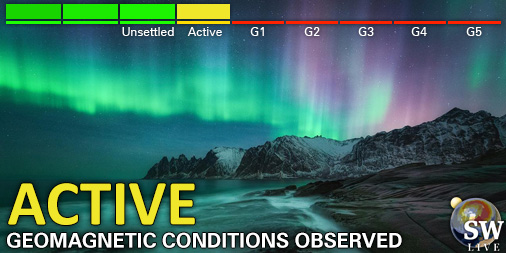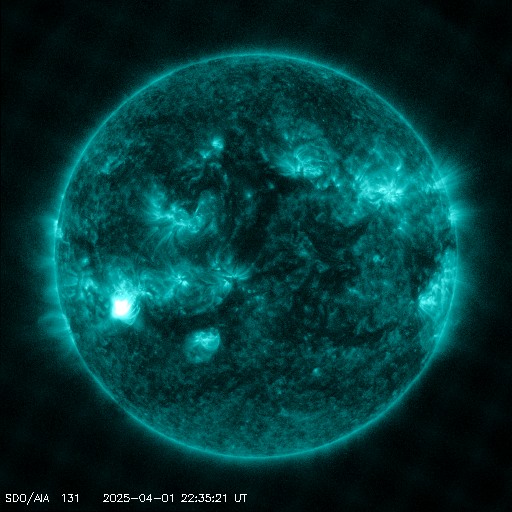Viewing archive of Saturday, 15 June 2002
Solar activity report
Any mentioned solar flare in this report has a scaling factor applied by the Space Weather Prediction Center (SWPC). Because of the SWPC scaling factor, solar flares are reported as 42% smaller than for the science quality data. The scaling factor has been removed from our archived solar flare data to reflect the true physical units.
Report of Solar-Geophysical Activity 2002 Jun 15 2200 UTCPrepared by the NOAA © SWPC and processed by SpaceWeatherLive.com
Joint USAF/NOAA Report of Solar and Geophysical Activity
SDF Number 166 Issued at 2200Z on 15 Jun 2002IA. Analysis of Solar Active Regions and Activity from 14-2100Z to 15-2100Z
Solar activity has been low. The largest event was an
optically uncorrelated C1.7 flare at 15/0058 UTC. Lesser C- and
B-class flare activity occurred in Region 0000 (N18E36), Region 1
(N20E38), and newly numbered Region 3 (N00E63). Region 9997
(N12E31) was combined with former Region 9998 to produce a single
beta-class group of penless spots. Other regions that emerged on
the disk and were numbered today included Region 2 (S24W08) and
Region 4 (S16E10).
IB. Solar Activity Forecast
Solar activity is expected to be
predominantly low. A small chance for an isolated moderate flare
exists for the period.
IIA. Geophysical Activity Summary 14-2100Z to 15-2100Z
The geomagnetic field was mainly quiet. One isolated unsettled
period was observed at higher latitudes near the end of the period.
IIB. Geophysical Activity Forecast
The geomagnetic field is
expected to be predominantly quiet for the next three days.
III. Event Probabilities 16 Jun to 18 Jun
| Class M | 25% | 30% | 30% |
| Class X | 01% | 01% | 01% |
| Proton | 01% | 01% | 01% |
| PCAF | green | ||
IV. Penticton 10.7 cm Flux
Observed 15 Jun 135 Predicted 16 Jun-18 Jun 140/145/145 90 Day Mean 15 Jun 178
V. Geomagnetic A Indices
Observed Afr/Ap 14 Jun 004/007 Estimated Afr/Ap 15 Jun 003/006 Predicted Afr/Ap 16 Jun-18 Jun 008/008-005/008-005/008
VI. Geomagnetic Activity Probabilities 16 Jun to 18 Jun
| A. Middle Latitudes | |||
|---|---|---|---|
| Active | 15% | 10% | 10% |
| Minor storm | 01% | 01% | 01% |
| Major-severe storm | 01% | 01% | 01% |
| B. High Latitudes | |||
|---|---|---|---|
| Active | 20% | 15% | 15% |
| Minor storm | 05% | 05% | 05% |
| Major-severe storm | 01% | 01% | 01% |
All times in UTC
Current data suggests there is a slight possibility for aurora to appear at the following high latitude regions in the near future
Norilsk, VorkutaLatest news
Latest forum messages
AR4046 160Unspecified geomagnetic activity 2190Unexplained proton activity 55AR14028 2025/03/21 CME 2025/03/23 G3 Watch 348Similar AR 3664 vs AR 4048 ??? 11
More topicsSupport SpaceWeatherLive.com!
A lot of people come to SpaceWeatherLive to follow the Sun's activity or if there is aurora to be seen, but with more traffic comes higher server costs. Consider a donation if you enjoy SpaceWeatherLive so we can keep the website online!

Latest alerts
13:03 UTC - Hemispheric Power Index
The OVATION model predicts the Hemispheric Power Index to reach 50GW at 13:56 UTC
Wednesday, 2 April 2025
04:03 UTC - Hemispheric Power Index
The OVATION model predicts the Hemispheric Power Index to reach 50GW at 04:56 UTC
01:45 UTC - Geomagnetic activity
Active geomagnetic conditions (Kp4) Threshold Reached: 01:32 UTC
Tuesday, 1 April 2025
22:51 UTC - Solar flare
Moderate M2.5 flare
22:30 UTC - Radio Blackout
Minor R1 radio blackout in progress (≥M1 - current: M1.45)
Space weather facts
| Last X-flare | 2025/03/28 | X1.1 |
| Last M-flare | 2025/04/01 | M2.5 |
| Last geomagnetic storm | 2025/03/27 | Kp5 (G1) |
| Spotless days | |
|---|---|
| Last spotless day | 2022/06/08 |
| Monthly mean Sunspot Number | |
|---|---|
| February 2025 | 154.6 +17.6 |
| April 2025 | 152.5 -2.1 |
| Last 30 days | 130.7 -17.9 |




